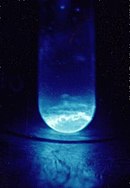 | |||||||||||||||||||||||||||||||||||||||||||||
| Einsteinium | |||||||||||||||||||||||||||||||||||||||||||||
|---|---|---|---|---|---|---|---|---|---|---|---|---|---|---|---|---|---|---|---|---|---|---|---|---|---|---|---|---|---|---|---|---|---|---|---|---|---|---|---|---|---|---|---|---|---|
| Pronunciation | /aɪnˈstaɪniəm/ | ||||||||||||||||||||||||||||||||||||||||||||
| Appearance | silvery; glows blue in the dark | ||||||||||||||||||||||||||||||||||||||||||||
| Mass number | [252] | ||||||||||||||||||||||||||||||||||||||||||||
| Einsteinium in the periodic table | |||||||||||||||||||||||||||||||||||||||||||||
| |||||||||||||||||||||||||||||||||||||||||||||
| Atomic number (Z) | 99 | ||||||||||||||||||||||||||||||||||||||||||||
| Group | f-block groups (no number) | ||||||||||||||||||||||||||||||||||||||||||||
| Period | period 7 | ||||||||||||||||||||||||||||||||||||||||||||
| Block | f-block | ||||||||||||||||||||||||||||||||||||||||||||
| Electron configuration | [Rn] 5f11 7s2 | ||||||||||||||||||||||||||||||||||||||||||||
| Electrons per shell | 2, 8, 18, 32, 29, 8, 2 | ||||||||||||||||||||||||||||||||||||||||||||
| Physical properties | |||||||||||||||||||||||||||||||||||||||||||||
| Phase at STP | solid | ||||||||||||||||||||||||||||||||||||||||||||
| Melting point | 1133 K (860 °C, 1580 °F) | ||||||||||||||||||||||||||||||||||||||||||||
| Boiling point | 1269 K (996 °C, 1825 °F) (estimated) | ||||||||||||||||||||||||||||||||||||||||||||
| Density (near r.t.) | 8.84 g/cm3 | ||||||||||||||||||||||||||||||||||||||||||||
| Atomic properties | |||||||||||||||||||||||||||||||||||||||||||||
| Oxidation states | common: +3 +2,[1] +4 | ||||||||||||||||||||||||||||||||||||||||||||
| Electronegativity | Pauling scale: 1.3 | ||||||||||||||||||||||||||||||||||||||||||||
| Ionization energies |
| ||||||||||||||||||||||||||||||||||||||||||||
| Other properties | |||||||||||||||||||||||||||||||||||||||||||||
| Natural occurrence | synthetic | ||||||||||||||||||||||||||||||||||||||||||||
| Crystal structure | face-centered cubic (fcc) | ||||||||||||||||||||||||||||||||||||||||||||
| Magnetic ordering | paramagnetic | ||||||||||||||||||||||||||||||||||||||||||||
| CAS Number | 7429-92-7 | ||||||||||||||||||||||||||||||||||||||||||||
| History | |||||||||||||||||||||||||||||||||||||||||||||
| Naming | after Albert Einstein | ||||||||||||||||||||||||||||||||||||||||||||
| Discovery | Lawrence Berkeley National Laboratory (1952) | ||||||||||||||||||||||||||||||||||||||||||||
| Isotopes of einsteinium | |||||||||||||||||||||||||||||||||||||||||||||
| |||||||||||||||||||||||||||||||||||||||||||||
Einsteinium is a synthetic chemical element; it has symbol Es and atomic number 99. It is named after Albert Einstein and is a member of the actinide series and the seventh transuranium element.
Einsteinium was discovered as a component of the debris of the first hydrogen bomb explosion in 1952. Its most common isotope, einsteinium-253 (253Es; half-life 20.47 days), is produced artificially from decay of californium-253 in a few dedicated high-power nuclear reactors with a total yield on the order of one milligram per year. The reactor synthesis is followed by a complex process of separating einsteinium-253 from other actinides and products of their decay. Other isotopes are synthesized in various laboratories, but in much smaller amounts, by bombarding heavy actinide elements with light ions. Due to the small amounts of einsteinium produced and the short half-life of its most common isotope, there are no practical applications for it except basic scientific research. In particular, einsteinium was used to synthesize, for the first time, 17 atoms of the new element mendelevium in 1955.
Einsteinium is a soft, silvery, paramagnetic metal. Its chemistry is typical of the late actinides, with a preponderance of the +3 oxidation state; the +2 oxidation state is also accessible, especially in solids. The high radioactivity of 253Es produces a visible glow and rapidly damages its crystalline metal lattice, with released heat of about 1000 watts per gram. Studying its properties is difficult due to 253Es's decay to berkelium-249 and then californium-249 at a rate of about 3% per day. The longest-lived isotope of einsteinium, 252Es (half-life 471.7 days) would be more suitable for investigation of physical properties, but it has proven far more difficult to produce and is available only in minute quantities, not in bulk.[3] Einsteinium is the element with the highest atomic number which has been observed in macroscopic quantities in its pure form as einsteinium-253.[4]
Like all synthetic transuranium elements, isotopes of einsteinium are very radioactive and are considered highly dangerous to health on ingestion.[5]
- ^ Greenwood, Norman N.; Earnshaw, Alan (1997). Chemistry of the Elements (2nd ed.). Butterworth-Heinemann. p. 28. ISBN 978-0-08-037941-8.
- ^ Kondev, F. G.; Wang, M.; Huang, W. J.; Naimi, S.; Audi, G. (2021). "The NUBASE2020 evaluation of nuclear properties" (PDF). Chinese Physics C. 45 (3): 030001. doi:10.1088/1674-1137/abddae.
- ^ Einsteinium Archived 2021-05-19 at the Wayback Machine. periodic.lanl.gov
- ^ Cite error: The named reference
h1579was invoked but never defined (see the help page). - ^ Cite error: The named reference
CRCwas invoked but never defined (see the help page).

